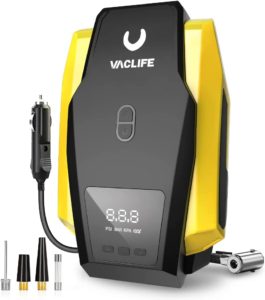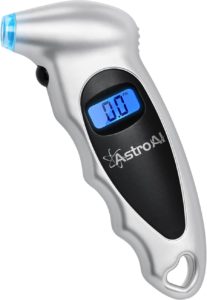Steps to Reset 2018 - Present Mazda 6 TPMS
Step 1: Check and Adjust the Tire Pressure
Your 2018 – 2021 Mazda 6 does not have a tire pressure reset button. This makes it essential to learn how to reset the tire pressure warning light. On your driver’s side door there is a yellow sticker in the door jamb. Set all 4 tires to the exact pressure levels on the sticker. If you have 19 inch wheels, set the front and rear to 35 Psi. If you have 17 inch wheels, set the front and rear to 36 Psi. Remember to adjust the tire pressure only when the tires are cold. (This means before driving long distances or after the car has been parked for a few hours)
Trim Model | Tire Size | Inflation PSI Front/Rear |
2018-2021 Mazda 6 | 225/45R19 | 35 PSI/35 PSI |
2018-2021 Mazda 6 | 225/55R17 | 36 PSI/36 PSI |
Step 2: Drive the Car
After adjusting your tire pressures to the correct pressure, drive your car. Mazda says you need to drive the car at over 16 Mph for at least 3 minutes. Basically this means, just go for a short drive. After driving the vehicle, the tire pressure light will go off. In my experience, the tire light has taken up to 15 or 20 minutes of driving to finally go off. Be patient!
Step 3: Re-Check Tire Pressure
If the tire pressure light doesn’t turn off after you’ve completed steps 1 and 2, take another look at your tire pressure. Make sure it’s still set to the exact level you initially adjusted it to. If it’s not, there’s a good chance you’re dealing with a tire leak or even a puncture. And if the tire light goes off but comes back on later, you can be pretty sure you’ve got a tire leak on your hands.
These steps work for all Mazda 6 Models including: Mazda6 Sport, Mazda6 Touring, Mazda6 Carbon Edition, Mazda6 Grand Touring, Mazda6 Grand Touring Reserve, Mazda6 Signature.
Steps to Reset 2013-2018 Mazda 6 TPMS
If your Mazda 6 Does not have the reset button, follow the procedure above.
Adjust all 4 tires to the recommended levels.
Turn the ignition switch to the “ON” position or with the car running.
Press and hold the tire pressure monitoring system (TPMS) BUTTON until the TPMS indicator light in the instrument cluster flashes twice.
RELEASE the TPMS button. The TPMS indicator light will turn off.
DRIVE THE VEHICLE at speeds above 16 mph (25 km/h) for at least 10 minutes.
TIP: If the tire pressure light won’t go out after following these steps, double check your air pressure manually with a digital tire pressure gauge and then repeat the entire reset procedure. (There is a tire pressure gauge we recommend at the bottom of this page)
Trim Model | Tire Size | Inflation PSI Front/Rear |
2013-2018 Mazda 6 | 225/45R19 | 35 PSI/35 PSI |
2013-2018 Mazda 6 | 225/55R17 | 36 PSI/36 PSI |
Mazda 6 TPMS Malfunction Indicator
Your Mazda 6 comes with a TPMS malfunction indicator that alerts you if the system isn’t working properly. This indicator works alongside the low tire pressure warning light. When the tire monitoring system experiences a problem, the warning light will flash for about a minute before staying on continuously. This pattern repeats every time you start your car until the issue is fixed. When the malfunction indicator is on, the system might not be able to detect or signal low tire pressure as designed. In other words, the tire pressure monitoring system won’t work correctly until the TPMS problem is taken care of. In short, a flashing tire pressure light signals an issue with the TPMS system itself, not an air pressure problem. So, if you have a defective tire pressure sensor, your TPMS will not function properly.
Always Reset Your TPMS in these Cases:
After tire pressure has been adjusted.
After a pressure sensor has been replaced.
After tire rotation has been performed.
After tire balances or wheel alignments.
After any tire or wheel has been replaced. Or removed and put back on.
After when the vehicle battery dies, been drained, or jumped.
After the TPMS light turns on.
How Your Mazda 6 TPMS Works
Pressure Sensors in Tires: Each tire has its own pressure sensor that measures the air pressure inside each tire.
Data Transfer: These pressure sensors send real-time tire pressure information wirelessly to the car’s computer via radio frequency. This includes pressure and temperature.
Sensor Battery Life: Tire pressure sensors run on small watch batteries that typically last for around 5 to 7 years. You cannot replace these batteries. You have to replace the entire sensor when the battery dies.
Vehicle Startup: Everytime you start your Mazda 6, the TPMS automatically activates and starts collecting data from the tire pressure sensors.
Continuous monitoring: The system constantly monitors tire pressure, making sure it stays within the recommended limits.
Warning thresholds: The TPMS has predefined pressure thresholds for each tire.
Pressure Changes: If tire pressure goes beyond the established thresholds (either too high or too low), the TPMS sets off a warning light and noise.
Error codes: As well as the warning light, the TPMS may also give error codes or specific details about which sensor has problems if scanned with a TPMS diagnostic tool.
What Causes the TPMS Light to Turn On
Low tire pressure: The most common cause, when one or more tires are underinflated, falling below the manufacturer’s recommended pressure level.
Overinflated tires: If a tire is inflated beyond the recommended pressure, the can sometimes cause the tire light to turn on.
Seasonal temperature changes: When the temperature drops, tire pressure decreases in tires.
Wheel without sensor: Most donuts and spare tires do not have pressure sensors.
Snow and Ice: Excess amounts of snow or ice around the wheels or valves
Sensor malfunction: A faulty tire pressure sensor may provide inaccurate readings, triggering the warning light.
TPMS battery issues: A low or dead battery in a tire pressure sensor will cause the system to activate a TPMS malfunction light explained above.
TPMS malfunction: An issue with the TPMS receiver module will also cause the malfunction indicator.
Radio Interference: Radio frequency interference from devices inside the vehicle or outside the vehicle. (example: alarm systems or cellular towers can occasionally set off TPMS when driving by)
How Air Temperature Affects Tire Pressure
During winter and colder seasons, the ambient air temperature drops, causing tire temperatures to decrease as well. As air temperature falls, tire pressure also reduces. Consequently, the TPMS warning light will turn on more often. The chart above illustrates the correlation between air temperature and tire pressure changes in both Fahrenheit and Celsius, as well as tire PSI and kPa units. The baseline temperature for checking tire pressure is 62°F (16.7°C), where no real tire pressure changes will occur. Basically, for every 10 degree Fahrenheit drop in air temperature, about 1 Psi air pressure will decrease.
The Benefits of Mazda 6 TPMS:
Enhanced safety: Monitors tire pressure to help prevent blowouts or accidents caused by underinflated or overinflated tires.
Improved fuel efficiency: Properly inflated tires reduce rolling resistance, increasing fuel efficiency.
Extended tire life: Maintaining optimal tire pressure helps reduce uneven tread wear and prolongs tire lifespan.
Better handling and performance: Optimal tire pressure ensures consistent and reliable vehicle handling.
Reduced CO2 emissions: Improved fuel efficiency contributes to lower greenhouse gas emissions.
Cost savings: Longer-lasting tires and better fuel economy can save you money over time.
Increased braking efficiency: Proper tire pressure provides better contact with the road, improving braking performance. This will also save you money on brake pads and rotors.
Greater ride comfort: Adequately inflated tires provide a smoother ride.
Early warning system: Alerts the driver to potential tire issues before they become critical.
Maintenance reminder: Encourages regular tire pressure checks and maintenance, ensuring safe driving conditions
Peace of mind: Drivers can trust that their vehicle is continuously monitoring tire pressure for their safety and comfort.
Conclusion
Resetting the tire pressure warning light on a 2023 Mazda 6 is an easy process that can be completed in just a few easy steps. Remember, always set your tire pressures when your tires are cold, and check your pressures at least once a month and before taking any trips!
Please note that this blog post contains Amazon affiliate links. This means that if you make a purchase through one of these links, the author of the blog may earn a small commission at no extra cost to you. The author only recommends products that they personally use and believe in. Thank you for supporting this blog.





